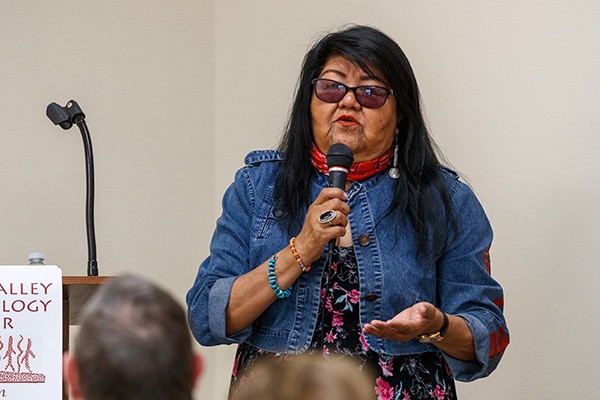The Verde Valley Archaeology Center hosted an Earth Day talk with artist and community activist Yolanda Hart Stevens, a Pee-Posh and Kwatsan from the Yuman Peoples of the Colorado River, on April 22.
Stevens is an artist in residence at the Heard Museum and a member of the Indigenous Artists Continuum who shares her knowledge of traditional dance and bead working with youth at various community events. Her art has been featured in exhibitions as far away as New Zealand.
In her presentation, Stevens addressed her relationship with the mesquite tree and its many uses, especially in her artwork. She said that she feels the closest connection to the mesquite tree of all parts of nature and that it is an integral part of life, from birth to death.
The sap, for instance, was referred to by elders as the tree crying. Stevens recalled her mother calling the sap candy and eating it, as well as the use of mesquite sap for tattooing and hair coloring.
“This is the relationship we have to it and how we use it as a tool,” Stevens said, sharing an image of her daughter using a mesquite stump to pound clay. She also showed the audience an example of a mesquite cradleboard that even incorporated the root of the tree.
Stevens primarily makes clay beads and uses mesquite to dye them rather than painting them. She cooks the bark for a few hours, then soaks the beads in it for an organic black tone, and uses mesquite as firewood while firing the beads. She also chooses clay from different sites, which can provide different colors naturally. Caliche is her material of choice and she rolls her beads by hand.
In Yuman tattoo culture, women only receive lines and dots as tattoos, so Stevens paints her beads only with similar lines and dots as a representation of her culture. She said that people should be able to look at her work and know the beads came from the Colorado River.
Mesquite beans can be ground into meal and added to foods for flavor, but Stevens warned listeners that they should be careful, that it will go right through them. She remembered how her parents used the beans as horse treats and how, when she was part of an eagle-watching pilot program, her outdoor office was made of mesquite, a timeless practice.
While sharing her skills at a local Boys’ & Girls’ Club, Stevens helped children learn to make tiles out of clay. She also sculpts clay tobacco pipes, and argued that tobacco has since been misused instead of being saved for prayer, meditation and blessings.
Her latest art piece incorporates pieces of clay on a black background, which represents asphalt, with a line in the middle of the road with her granddaughter’s footprints, representing a crossroad. Stevens regarded it as an expression of a feeling of reaching a point where the future becomes murky and undefined. “This is what we look like, it isn’t pretty or intact and is not what we want or expect,” Stevens said, adding that it was a very controversial piece.
Noting that problems face the desert and mesquite trees today, Stevens remarked that she often sees mesquite habitats being destroyed, but she added that the trees aren’t stupid, that they know what they are doing and will grow back.



